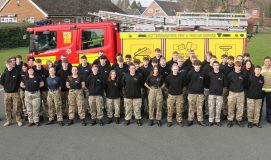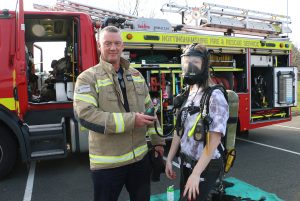Uniformed protective services students at West Nottinghamshire College learned what it takes to become a firefighter – after being put through their paces by a crew from Nottinghamshire Fire and Rescue Service.
More than 60 students on level 2 and level 3 public services courses were led through a series of simulated exercises designed to test their fitness, strength, manual dexterity and confidence levels.
A crew from Mansfield Fire Station’s ‘Blue Watch’ visited the college’s Derby Road campus, Mansfield, over three days to give students an insight into the role, highlight the career opportunities available, and take them through job-related tests.
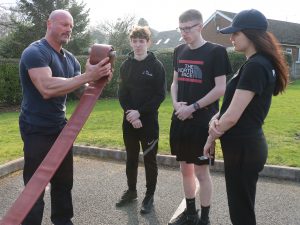
Crew manager Ian Edmonds shows students (from left) Baily Ford, Adam Tomlinson and Charlie-Francis Massey how to uncoil a 70mm hose.
Exercises included ‘hose-running’, which involved quickly unrolling coiled 45mm and 70mm hoses used to tackle a fire, and learning how to use a ‘throw line’ – a rescue device consisting of a length of rope inside a bag, used to assist someone experiencing difficulty in water.
Students also had the chance to take a look around the crew’s fire engine and try on breathing apparatus, which includes a cylinder of compressed air that allows the wearer to breathe safely in a smoky atmosphere, and perform exercises wearing the heavy-duty equipment.
They also completed the ‘bleep test’, sometimes referred to as a shuttle run, which is used by the fire and rescue service to test people’s cardiovascular fitness and stamina. It involves running back and forth between a set of cones 20 meters apart on a flat surface, starting at level one and finishing at level 23 – getting progressively harder as the levels get higher.
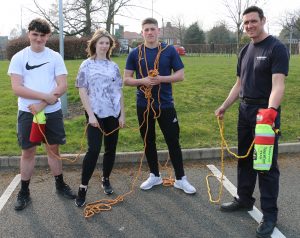
Firefighter Jim Broomhead shows students (from left) Dillon Baker, Zuzanna Soltys and Owen Harling a throw line.
In addition to teaching students about the UK fire and rescue service’s entry requirements, it gave them a chance to gain knowledge in areas such as responding to emergency service incidents, leadership, teamwork, communication, citizenship, diversity and human rights, understanding discipline, career planning, and employment in the uniformed protective services.
Firefighter Jim Broomhead, who led the activities, said: “It’s really important to expose students to these types of experiences, where they learn a range skills which will be vital in whichever area of uniformed service they aspire to work in.
“By doing these activities, some of them may decide that a role in the fire and rescue service is definitely what they want, so it gives them an insight into their future career as well. And those who want to go into other emergency services or the armed forces can still draw on those experiences when undergoing their tests, so it’s useful to all students.
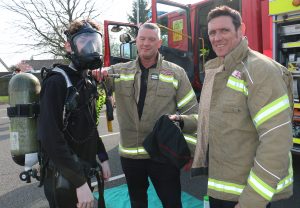
Student Baily Ford tries on the breathing apparatus, demonstrated by crew manager Paul Welsh (centre) and firefighter Jim Broomhead.
“Another benefit of visits such as these is the opportunity to promote general fire safety awareness, such as the importance of things like smoke alarms, which we tend to find a lot of people still don’t have in their homes. Just getting that message out there could save somebody’s life.
“The students were fantastic. It was great to receive such positive feedback from them and to see them progress throughout the exercises.”
Dillon Baker, 17, who studies the Level 3 Advanced Diploma in Public Services, said: “I really enjoyed it – not only the drills but also all the questions we were able to ask.
“The drills are the daily things you probably have to do in the fire service so it taught us that you have to stay alert at all times in that role and get into the mind-set where you’re ready and prepared to respond to an incident.
“I hadn’t thought about going into the fire service before this – I want to be an engineer in the Royal Navy – but I might change my mind now.”
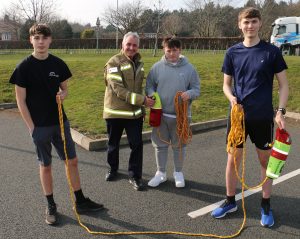
Firefighter Malc Ridge demonstrates a throw line to students (from left) Reece Budd, Mackenzie Elliott and Sam Martin.
Seventeen-year-old Charlie-Francis Massey, who also studies the Level 3 Advanced Diploma in Public Services, said: “It was inspirational because we got to see what firefighters do. You realise how hard their job is and what the physical demands are. They have to have a lot of strength to do what they need to do, particularly carrying the breathing equipment.
“The hose-running was quite cool and I enjoyed being inside the fire engine. The visit helped us realise how many career opportunities there are in the public services.”
Public services teacher Alan Viggers said: “This was an excellent opportunity for students to understand what is required to become employed within the fire and rescue service. It was wonderful to see the firefighters pass on their skills, knowledge and professionalism to our learners, who threw themselves into the tasks with enthusiasm and gained an invaluable understanding of the role.”
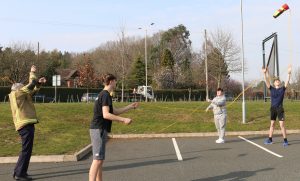
Students (from left) Reece Budd, Mackenzie Elliott and Sam Martin learn how to use a throw line, under the guidance of firefighter Malc Ridge.



 Posted on 4th Apr
Posted on 4th Apr